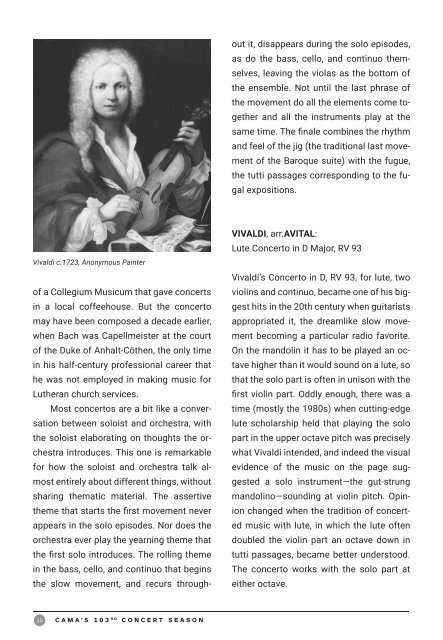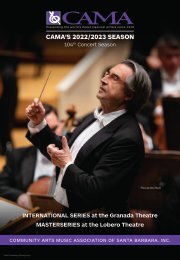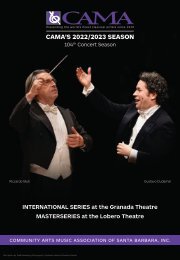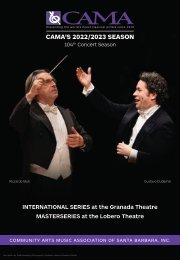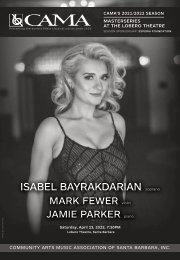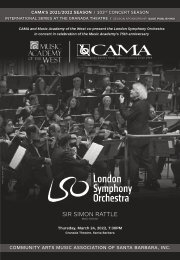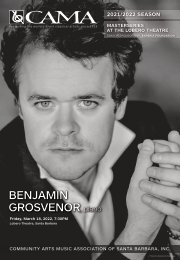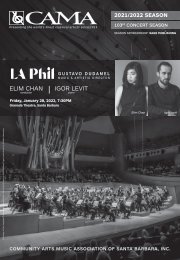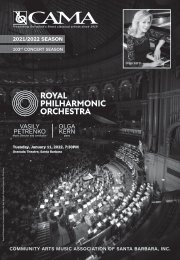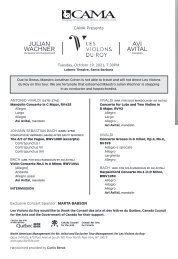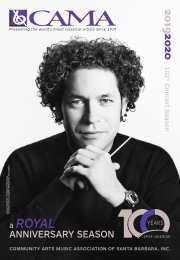Program Book — CAMA Presents Les Violons du Roy with Avi Avital — Tuesday, October 19, 2021 — Lobero Theatre, Santa Barbara, 7:30PM
Create successful ePaper yourself
Turn your PDF publications into a flip-book with our unique Google optimized e-Paper software.
Vivaldi c.1723, Anonymous Painter<br />
of a Collegium Musicum that gave concerts<br />
in a local coffeehouse. But the concerto<br />
may have been composed a decade earlier,<br />
when Bach was Capellmeister at the court<br />
of the Duke of Anhalt-Cöthen, the only time<br />
in his half-century professional career that<br />
he was not employed in making music for<br />
Lutheran church services.<br />
Most concertos are a bit like a conversation<br />
between soloist and orchestra, <strong>with</strong><br />
the soloist elaborating on thoughts the orchestra<br />
introduces. This one is remarkable<br />
for how the soloist and orchestra talk almost<br />
entirely about different things, <strong>with</strong>out<br />
sharing thematic material. The assertive<br />
theme that starts the first movement never<br />
appears in the solo episodes. Nor does the<br />
orchestra ever play the yearning theme that<br />
the first solo introduces. The rolling theme<br />
in the bass, cello, and continuo that begins<br />
the slow movement, and recurs throughout<br />
it, disappears during the solo episodes,<br />
as do the bass, cello, and continuo themselves,<br />
leaving the violas as the bottom of<br />
the ensemble. Not until the last phrase of<br />
the movement do all the elements come together<br />
and all the instruments play at the<br />
same time. The finale combines the rhythm<br />
and feel of the jig (the traditional last movement<br />
of the Baroque suite) <strong>with</strong> the fugue,<br />
the tutti passages corresponding to the fugal<br />
expositions.<br />
VIVALDI, arr.AVITAL:<br />
Lute Concerto in D Major, RV 93<br />
Vivaldi’s Concerto in D, RV 93, for lute, two<br />
violins and continuo, became one of his biggest<br />
hits in the 20th century when guitarists<br />
appropriated it, the dreamlike slow movement<br />
becoming a particular radio favorite.<br />
On the mandolin it has to be played an octave<br />
higher than it would sound on a lute, so<br />
that the solo part is often in unison <strong>with</strong> the<br />
first violin part. Oddly enough, there was a<br />
time (mostly the 1980s) when cutting-edge<br />
lute scholarship held that playing the solo<br />
part in the upper octave pitch was precisely<br />
what Vivaldi intended, and indeed the visual<br />
evidence of the music on the page suggested<br />
a solo instrument<strong>—</strong>the gut-strung<br />
mandolino<strong>—</strong>sounding at violin pitch. Opinion<br />
changed when the tradition of concerted<br />
music <strong>with</strong> lute, in which the lute often<br />
doubled the violin part an octave down in<br />
tutti passages, became better understood.<br />
The concerto works <strong>with</strong> the solo part at<br />
either octave.<br />
15 <strong>CAMA</strong>'S 103 RD CONCERT SEASON


